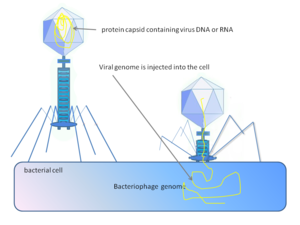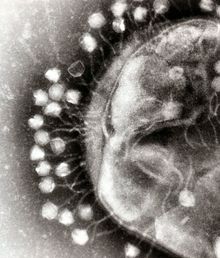Phage therapy is the therapeutic use of bacteriophages to treat pathogenic bacterial infections. Although extensively used and developed mainly in former Soviet Union countries for about 90 years, this method of therapy is still being tested elsewhere for treatment of a variety of bacterial and poly-microbial biofilm infections, and has not yet been approved in countries other than Georgia. Phage therapy has many potential applications in human medicine as well as dentistry, veterinary science, and agriculture.[1] If the target host of a phage therapy treatment is not an animal the term "biocontrol" (as in phage-mediated biocontrol of bacteria) is usually employed, rather than "phage therapy".
Bacteriophages are much more specific than more common drugs, so they can hypothetically be chosen to be indirectly harmless not only to the host organism (human, animal, or plant), but also to other beneficial bacteria, such as gut flora, reducing the chances of opportunistic infections. They would have a high therapeutic index, that is, phage therapy would be expected to give rise to few if any side effects, as opposed to drugs, and would not stress the liver.[citation needed] Because phages replicate in vivo, a smaller effective dose can be used. On the other hand, this specificity is also a disadvantage: a phage will only kill a bacterium if it is a match to the specific strain. Consequently phage mixtures are often applied to improve the chances of success, or samples can be taken and an appropriate phage identified and grown.
Phages are currently being used therapeutically to treat bacterial infections that do not respond to conventional antibiotics, particularly in the country of Georgia.[2][3][4] They tend to be more successful than antibiotics where there is a biofilm covered by a polysaccharide layer, which antibiotics typically cannot penetrate.[5] In the West, no therapies are currently authorized for use on humans, although phages for killing food poisoning bacteria (Listeria) are now in use.[6]


No comments:
Post a Comment